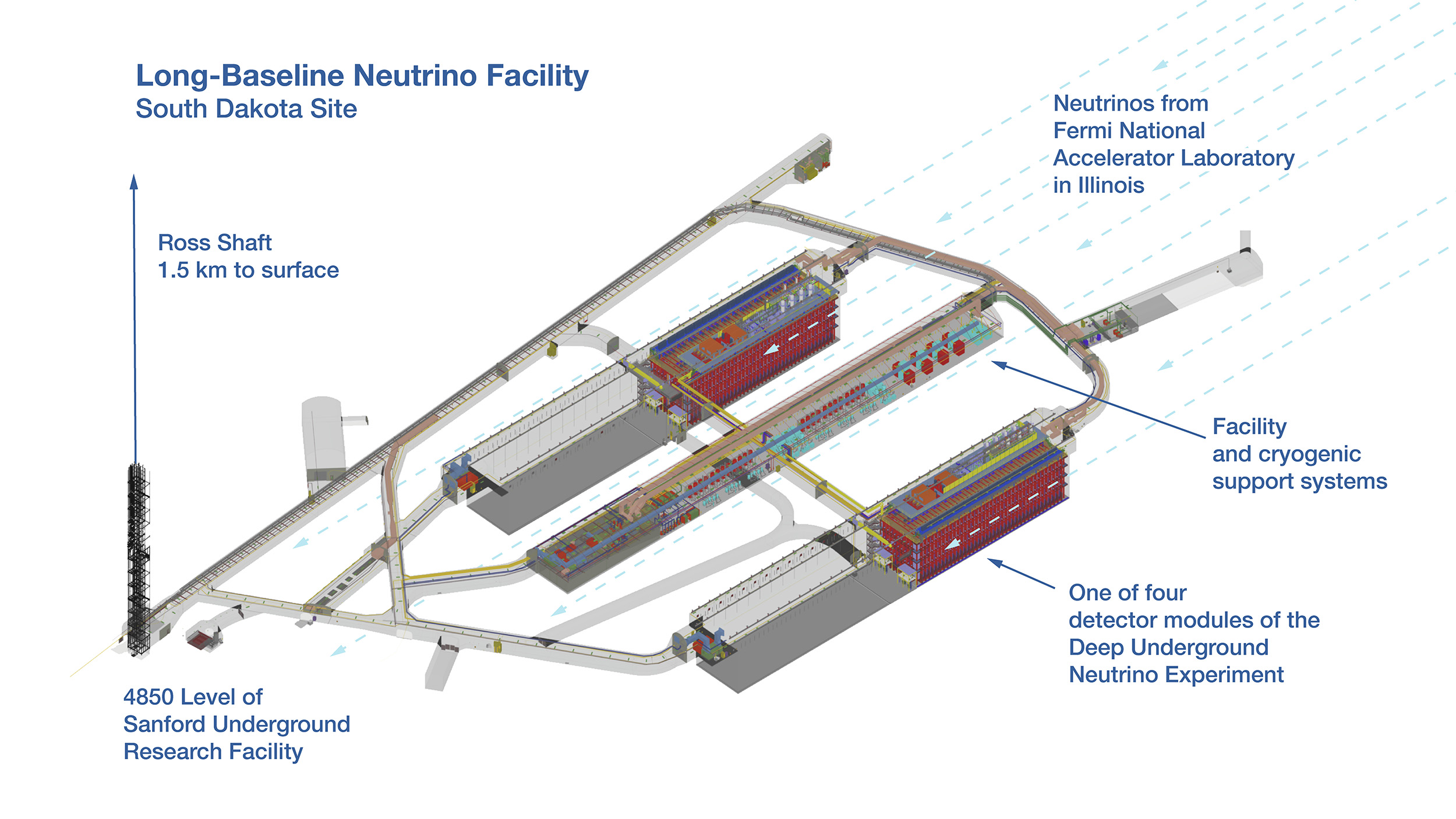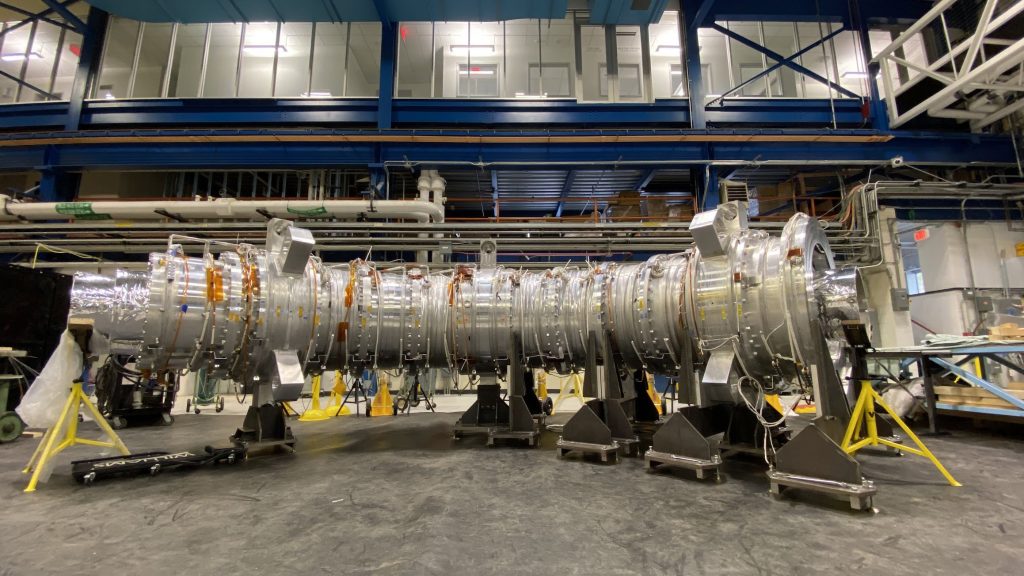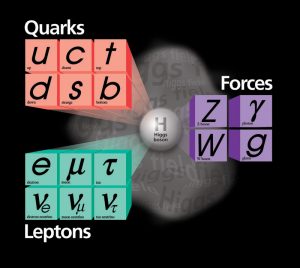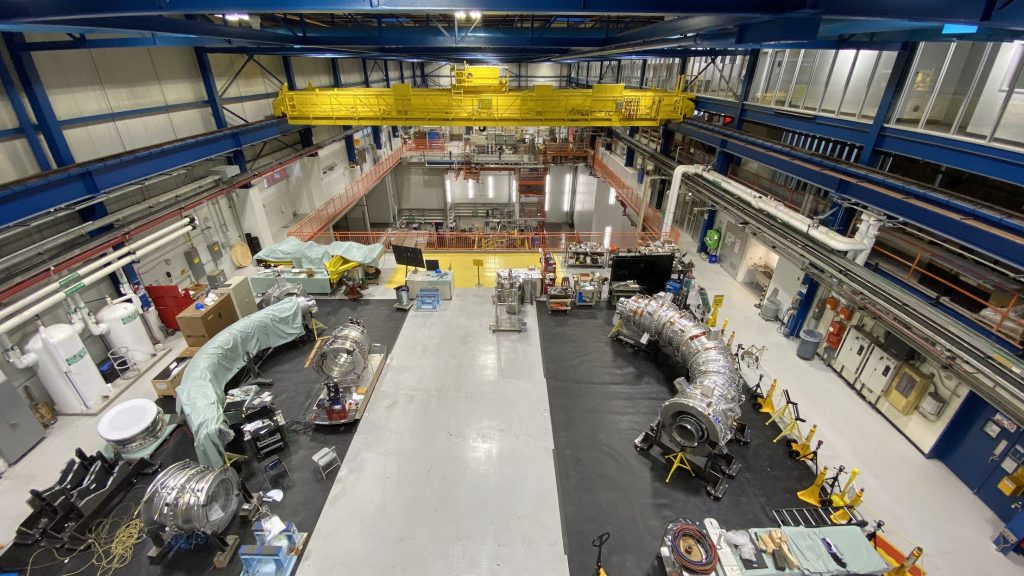
David Ibbett has created music from neutrino data as Fermilab’s inaugural guest composer. Photo: Nile Scott Photography
Fermilab guest composer David Ibbett will premiere “MicroBooNE” at a virtual concert on Tuesday, Dec. 8, at 7:30 p.m. CST.
When a neutrino collides with an atom inside one of Fermilab’s detectors, it sets off a cascade of charged particles. Scientists can turn the data into images that show the paths taken by the particles and reveal the neutrino’s properties. But what would this event sound like?
David Ibbett, Fermilab’s first guest composer, has been exploring that question during his 2020 residency at the lab. Through a process known as “data sonification,” Ibbett converts real scientific data into the notes and rhythms that form the basis of his music.
Ibbett’s latest piece is a sonification of data from Fermilab’s MicroBooNE experiment. In this interview, he shares an excerpt of the song, explains the science behind it and describes his compositional process.
Listen to the audio interview:
The entire piece, also called “MicroBooNE,” will have its world premiere at a virtual concert on Tuesday, Dec. 8, at 7:30 p.m. CST. An evening of interwoven talks and performances, Neutrino Music: A Composer’s Journey will feature Ibbett’s ongoing Neutrino Music project as well as music inspired by exoplanet research. The event is part of the Fermilab Arts and Lecture Series. Tickets are free, but registration is required. Find out more and register to attend.
The above animation shows the particle tracks from a collision between a neutrino and an argon nucleus inside the MicroBooNE detector, synced with an excerpt from David Ibbett’s composition “MicroBooNE.”
Below are the lyrics of the excerpt discussed in the interview:
—
Nu, proton, electron
Cascade, cascade, cascade
I counted up the blows that came our way
It’s not enough to turn my love away
Ionize inside!
Ionize inside, ionize inside!
Particles come raining down
Annihilates my pride
Tears are falling on the ground
In scintillating light
—
Beth Sterling — soprano
Joseph Ibbett — animation
Fermilab is supported by the Office of Science of the U.S. Department of Energy.
The Office of Science is the single largest supporter of basic research in the physical sciences in the United States and is working to address some of the most pressing challenges of our time. For more information, visit science.energy.gov.
Construction of the enormous underground facility for the largest international physics experiment in the United States took a major step forward as project managers at the Department of Energy’s Fermi National Accelerator Laboratory are preparing for the project’s next phase.
This month, Thyssen Mining Inc. was awarded the contract to excavate the gigantic caverns for Fermilab’s Long-Baseline Neutrino Facility. The caverns will be located a mile underground, rise up to seven stories tall and cover an area almost the size of two football fields.
Excavation crews will drill, blast and remove approximately 800,000 tons of rock to create the underground space for LBNF. When complete, the facility will house the enormous particle detector for the international Deep Underground Neutrino Experiment, hosted by Fermilab. More than 1,000 scientists from over 30 countries are collaborating on DUNE, which will provide the foundation for international neutrino research for decades to come.

The Long-Baseline Neutrino Facility will comprise three caverns to house and support the international Deep Underground Neutrino Experiment. The north and south caverns are identical in size (475 feet long x 65 feet wide x 92 feet high) and will house the gigantic DUNE particle detector modules. The central cavern (624 feet long x 64 feet wide x 37 feet high) will accommodate cryogenic equipment and other utilities needed for the experiment. Image: Fermilab
Excavation of the underground complex will take place at the Sanford Underground Research Facility in Lead, South Dakota, in space leased to the Department of Energy for this project.
The excavation will create underground space that will house the experiment as well as laboratory space, a maintenance shop, generator room, spray chamber and a series of interconnecting tunnels, called drifts, to connect the three large caverns in which the DUNE neutrino detector modules and utilities will be installed. The total footprint of the underground facility exceeds four acres (more than 16,000 square meters).
“Award of the main cavern excavation contract is a significant milestone for the LBNF/DUNE project and marks a major step towards the start of world-class science,” said Chris Mossey, Fermilab deputy director for LBNF/DUNE-US. “We’re excited to welcome Thyssen Mining to our team and start work on the next major phase of the project.”
Thyssen Mining has begun the early mobilization period of the contract. This period includes the onboarding of personnel, contracting local vendors and preparing equipment for use underground. On-site construction work will begin in April 2021.
“Our planned labor force for this project is expected to be between 110 and 120 people,” said U.S. General Manager Ryan Moe, Thyssen Mining. “Our team will consist of many of our trained and experienced miners, operators, mechanics, electricians, engineers and managers who have worked on multiple cavern projects within the Thyssen organization. We will in the near term, however, be posting numerous positions locally to fill in alongside with many of these similar roles. As our planning advances, we’ll have better information on the exact number of positions needed.
“Thyssen Mining strongly believes in supporting the community. Our observation in the past is that by engaging with the local community and hiring local employees we benefit from their experiences; and in this community there is a rich tradition of mining legacy. We would seek individuals who have worked locally that may provide knowledge and experience that will help us be successful.”
The excavated rock will be hoisted up a vertical shaft from one mile underground and then transferred 4,200 feet on a system of conveyor belts that was built this year by Kiewit Alberici Joint Venture, the construction manager and general contractor for the LBNF project. When operational, the new rock transportation system will move the rock from the hoist to a former open cut mining pit in Lead, South Dakota.
The conveyor itself should not create any noticeable noise; however, the falling of rock from the conveyor into the open cut may generate audible noise, within the limits permitted by city ordinance. A letter to local residents provides more information.
When the caverns are complete, the LBNF and DUNE teams will install the infrastructure and equipment needed for neutrino research. Using the particle accelerator complex at Fermilab, scientists will send an intense neutrino beam through 1,300 kilometers of rock from Illinois to the DUNE particle detector in South Dakota to understand the role that neutrinos – the most abundant matter particles in the universe – play in our cosmos. This 2-minute video explains in more detail how LBNF and DUNE work.
The short animation below shows a virtual walk through the South Dakota-portion of Fermilab’s Long-Baseline Neutrino Facility, which will house the huge detector of the international Deep Underground Neutrino Experiment.
The Long-Baseline Neutrino Facility and Deep Underground Neutrino Experiment are supported by the Department of Energy Office of Science.
Fermilab is supported by the Office of Science of the U.S. Department of Energy. The Office of Science is the single largest supporter of basic research in the physical sciences in the United States and is working to address some of the most pressing challenges of our time. For more information, visit science.energy.gov.
The construction of the Mu2e experiment at the Department of Energy’s Fermilab has reached an important milestone. A crucial section of magnets for the experiment, including components from Italy, Japan and the United States, has passed the rigorous testing necessary to ensure that each individual magnet meets the performance required for the experiment.
Those magnets, part of a section called the transport solenoid, will be pieced together to form a novel part of the Mu2e project. The Mu2e project has reached 80% completion overall, according to Mu2e Project Manager Ron Ray.
When operational, the Mu2e experiment will reach 10,000 times the sensitivity of previous experiments looking for the direct conversion of a muon into an electron to test one of the fundamental symmetries in particle physics.

Recently, the Mu2e experiment received and tested the seven superconducting units, shown here, that form the first portion of the transport solenoid. Rigorous testing of the individual units, which were manufactured in industry, ensures they meet the performance required for the experiment. Photo: Vito Lombardo, Fermilab
Why muons?
Muons may be the key to unraveling a confounding mystery in particle physics. The mystery stems from the Standard Model, or, more accurately, the holes within the Standard Model.
In the latter half of the 20th century, scientists developed what has become known as the Standard Model of physics. The model relates three of the four fundamental forces – the electromagnetic, the weak and the strong force – to each other. It also classifies all known elementary particles.

In the Standard Model of particle physics, the muon is in a family of particles called leptons (upper row of the green grid on lower left). Each lepton has a partner particle called a neutrino (bottom row of green grid). Unlike their partners, neutrinos lack electric charge. Scientists have observed neutrinos morphing between their three types, and they have reason to believe that the charged leptons might do the same. Image: Fermilab
But from the beginning, the Standard Model has left certain phenomena unexplained. It doesn’t include the universe’s fourth force, gravity, nor does it address the accelerating expansion of the universe due to dark energy or the existence of dark matter.
So where do muons come in?
In the Standard Model, the muon, along with the electron and tau, are in a family of particles called leptons. Each lepton has a partner particle called a neutrino: the muon neutrino, electron neutrino and tau neutrino. Unlike their partners, neutrinos lack electric charge. Scientists have observed neutrinos morphing between their three types, and they have reason to believe that the charged leptons might do the same. All they need is the right kind of experiment to find out.
The right kind of experiment
That’s where Mu2e comes in.
The experiment is about one-third the length of a football field and will be 10,000 times more precise when it comes to looking for this muon-to-electron conversion than a similar, previous experiment called SINDRUM II. One of the key differences from previous experiments is Mu2e’s system of three superconducting magnet systems: the production solenoid, the transport solenoid and the detector solenoid.
The production solenoid is where the muons are created. A beam of protons hits a target, and the interaction eventually produces muons. With the help of magnets, these muons then spiral down the S-shaped transport solenoid.
The transport solenoid, a critical part of the experimental setup, is divided into two halves. Muons travel down the first half of the curvy corridor, where they are separated by charge. At the solenoid’s midway point, they encounter a special device that permits only negatively charged muons to pass through to the second curved section. The negative muons then exit the transport solenoid and enter the next big magnet, the detector solenoid. There, they stop in a second target.
It’s at this point that the magic happens — the magic of quantum mechanics.

The S-shaped Mu2e transport solenoid is divided into two halves. Muons travel down the first half of the curvy corridor, where they are separated by charge. At the solenoid’s midway point, they encounter a special device that permits only negatively charged muons to pass through to the second curved section. The negative muons then exit the transport solenoid and enter the next big magnet, the detector solenoid (the larger cylinder on the right). There, they stop in a second target. Image: Mu2e
When a negative muon hits a target, only one of two things can happen according to the Standard Model: Either the muon is captured by the nucleus, changing a proton into a neutron and leaving behind a neutrino, or the muon decays, emitting an electron and two neutrinos.
But Mu2e is looking for a third option: The transformation of a muon into only an electron, unaccompanied by the usual neutrino partners. The observation of this process would break the Standard Model wide open, demonstrating that one charged lepton can convert directly into another — a theorized process no one has ever witnessed.
“What we do at Fermilab is pure research, and we’re trying to enrich the human experience by helping people understand the universe and the world we live in,” Ray said. “And ultimately what this is all about is trying to complete the picture of the Standard Model by filling in some holes that we know exist.”
Construction of the transport solenoid
Making that all happen is even more difficult than it sounds, and the transport solenoid is an important part of the design of the experiment, enabling it to be sensitive enough to observe this rare phenomenon, if it exists. The transport solenoid was first proposed decades ago to address the limitations of previous muon-to-electron conversion experiments. Fermilab is the first to fully bring this novel idea to fruition.
But first all the parts need to come together.
Recently, Mu2e received and tested the seven superconducting units that form the first portion of the transport solenoid. Rigorous testing of the individual units, which were manufactured in industry, ensures they meet the performance required for the experiment.
“For this project, we are collaborating with industries scattered all over the world,” said Vito Lombardo, Mu2e manager for the transport solenoids. “The superconducting cables, the building blocks of these magnets, came from Japan, the superconducting units that form the S-shaped magnets are being manufactured in Italy and tested at Fermilab, while the cryostats and thermal shields, the devices that help keeping the magnets cold, are coming from the United States.”
Fermilab is coordinating this global partnership.
If the planning required for the experiment wasn’t complicated enough, the S-shape of the solenoid makes it more so: Each magnet unit is unique. This means that the magnets not only have to be assembled in a specific order but that the experiment cannot rely on spares.
“They’re a very funny shape,” explained Karie Badgley, one of the scientists working on Mu2e. “You can’t just order them as you might with other magnets, especially with the tight tolerances we require.”
The rigorous testing that Fermilab puts each of these magnets through takes about four months.
“It’s been a lot of big, important steps,” Badgley said. “That’s why it’s so exciting that this first half is almost done. We can finally start to put it together and see the whole magnet-aspect of the upstream section come together.”
With the seven magnets making up the first half of the transport solenoid accepted, the team is already putting the section together. Meanwhile, testing on the magnets for the second section kicks off.
Construction of Mu2e is expected to finish in 2023, and the experiment will be ready to start taking physics data shortly after.
The Mu2e experiment at Fermilab is supported by the Department of Energy Office of Science.
Fermilab is supported by the Office of Science of the U.S. Department of Energy. The Office of Science is the single largest supporter of basic research in the physical sciences in the United States and is working to address some of the most pressing challenges of our time. For more information, visit science.energy.gov.


